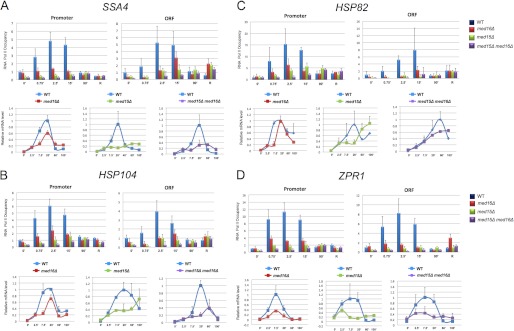FIGURE 6.

Tail subunit mutations reduce Pol II recruitment to, and mRNA expression of, HSP genes during the early stages of heat shock. A (top panels), Pol II occupancy at the SSA4 promoter and ORF either prior to or for the indicated times following an instantaneous 39 °C heat shock (recovery (R) conducted as in Fig. 1). Pol II abundance was determined by ChIP using a CTD polyclonal antibody; preimmune background was subtracted from each immune signal. Net values for each time point/strain combination were normalized to the MED+ strain at T = 0 min; promoter and ORF were quantified separately. Depicted are means ± S.D. (error bars); n = 3. Bottom panels, RT-qPCR analysis of SSA4 mRNA levels in MED+, med16Δ, med15Δ, and med15Δ med16Δ strains. SSA4 mRNA/SCR1 RNA quotients, normalized to the MED+ 20 min quotient (which was set to 1.0), are shown. Note that SCR1 is a structural RNA (Pol III transcript). Depicted are means ± S.D. (n = 2); each MED+ versus mutant pairwise comparison was conducted separately. B–D, Pol II occupancy at HSP104, HSP82, and ZPR1 promoter and ORF regions and associated mRNA expression levels were determined as in A.
